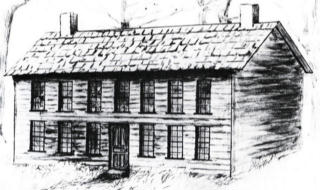Although
fewer than 250 settlers were present to participate in 1837 and 1838, Johnson
County did not escape the ubiquitous squabbles over the plum of being designated
as “the” county seat town.
Fought
in virtually every county in the American Midwest, the county-seat battle was
incarnated in Johnson County as Osceola versus Napoleon. Ironically, neither
town actually existed; in fact, the only three communities existing in the
county at the time all were established by Native Americans.
Further,
the non-existing towns were actually the same site, unclaimable Native American
land until another “purchase” became effective on Oct. 21, 1837. The site is
near present-day Napoleon Park along Sand Road at the southern edge of Iowa
City.
The
curious surviving record of the squabble is replete even with poetry, perhaps
foreshadowing Iowa City’s later claim as “the Athens of the Midwest,” a
late 18th and early 19th century puffery allusion to its seat of learning.
Napoleon
ostensibly won, being designated the county seat by Wisconsin territorial act of
June 22, 1838, just 11 days before the Territory of Iowa was created. But, when
officials of the new territory decided the following year to locate its capital
somewhere in Johnson County, the thought became widely accepted that the county
seat would flow into the new capital after a site was selected in May 1839.
On
Nov. 14, 1839, when the U.S. postmaster general appointed Chauncey Swan as the
new local postmaster, he also designated the post office name as Iowa City.
“Thus Napoleon was snuffed out,” notes an 1883 history of the county.
The
federal government allowed newly-forming county governments pre-emptive claim at
no cost to a quarter section of land, or 160 acres,
within their boundaries for
the purpose of selling lots to settlers to fund the new government and its first
buildings. Private claims typically cost $1.25 an acre.
Pre-emption
allowed government to take a site and force anyone on any part of it to choose
an unclaimed alternate site. The modern counterpart is the right of government
to use a process called eminent domain to take property and pay the owner for
it.
Johnson
County eventually chose the area from Court Street (the initial southern
boundary of Iowa City) south to Benton Street and from
the Iowa River east to
near Gilbert Street, selling off most of the claimed area as lots, but retaining
the current square block site of the Courthouse as its home base.
New
territories were allowed to choose a full section of land, a square mile or 640
acres, to establish its capital. The new Territory of Iowa picked the area now
called Section 10 of Iowa City Township in then uncharted wilderness.
It’s
now the heart of Iowa City between Court and Brown streets, stretching from
Summit Street to approximately the Iowa River, but actually crossing the river
near Iowa Avenue to take in the area east of what is now North Riverside Drive,
including the Levitt Center and Hancher Auditorium sites.
During
the latter 1830s, the sometimes light-hearted struggle between Osceola and
Napoleon resulted in surviving poetry.
Osceola
was the name of a Native American Seminole of Florida who starved himself to
death while being held prisoner. A few lines of the lengthy “Ode to Osceola”
in Johnson County run like this:
“And
long his memory will be dear; his name still sacred shall remain; for him a
monument we’ll rear on Iowa’s fair and flowery plain. We’ll build a
city
to his name – with church and stately tower adorn; high as the heavens shall
reach its fame, and in it none shall hunger, thirst or mourn.”
The
supporters of Napoleon fired back with their own salvo. A few lines of it
follow.
“Vain,
feeble worm! Presumptuous boy! How vain conceit doth lift thee up! ‘Ere long
shall trouble mar thy joy, for bitter sorrow thou shalt sup.” And later:
“Thy boasted church and stately tower, and monument with all its fame, shall
fall before my potent power, nor dare to speak thy plebian name.”
Some
early Johnson County settlers seemed to have enjoyed their political battles.
Next
Saturday: A
steeple atop Old Brick Church.
Bob
Hibbs collects local postcards and researches history related to them.
He may be
reached at 338-3175 or at hibbs@mchsi.com
Return
to Postcards Index

